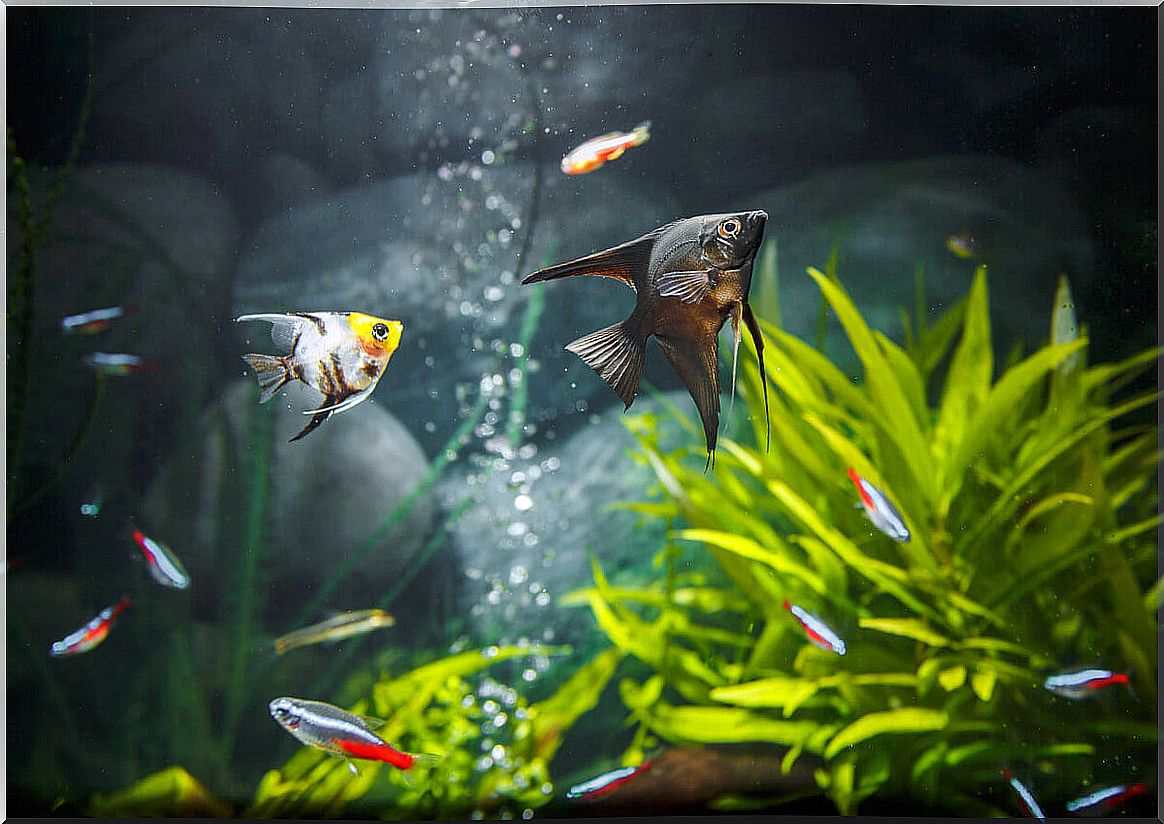Exophthalmos In Fish: Everything You Need To Know

Eye diseases are normal in fish ponds. Dirty water, lack of oxygenation, precarious cycling or the presence of sharp objects in the aquarium can damage the visual apparatus of the animals that inhabit it. Fish exophthalmos, also known as popeye disease in English, is one of the most common.
Anyway, it is important to note that some fish have this characteristic as a non-pathological trait. If you want to know everything about this condition of aquarium members, read on.
What is exophthalmos in fish?
Vision is a very important sense in many species of fish. The eyes of these vertebrates are similar to those of terrestrial animals, but they differ from others in that they have spherical lenses, not convex, as is the case with humans. They also have rods and cones, cells that specialize in photoreception, and tend to see colors.
The term exophthalmos refers to the remarkable propulsion of the eyeball from the orbital cavity that encloses it. This condition can occur in any vertebrate that has sizable eyes in the skull cavity, such as dogs, cats, and humans. In our species, this usually occurs from Graves-Basedow disease , as well as from traumatic lesions, tumors and abscesses.
On the other hand, fish can also present exophthalmos, but this condition can be pathological or human selection. Next, we’ll explore the reason for this unusual eye propulsion.

Symptoms
As its name in English indicates ( popeye, pop that stands out and eye, eye), the main symptom of exophthalmos in fish is that the animal has a protruding, swollen, and strange-looking eye. This is due to excess fluid in the eye sockets, which exerts pressure and forces the eye to protrude more than normal. In this state, the appearance of simultaneous bacterial infections is common.
In addition, it is very likely that the fish also have a whitish color in the ocular environment. This sign is a manifestation of the damage caused to the cornea, by excess pressure in the eye, mechanical stress and possible pathogens installed in the tissues. If the cause is a direct wound, the area may also have a bloody tint.
Causes of exophthalmos in fish
It is very important to differentiate exophthalmos into its 2 variants: unilateral and bilateral. Next, we’ll explore the particulars of each of them.
Unilateral exophthalmos
If only one of the 2 eyes is damaged, it is more likely that the fish has been injured by some aquarium material. The local swelling and sore will cause exophthalmos, which will certainly appear with sporadic bleeding as well.
In these cases, the best thing you can do is remove any unnatural ornaments from the aquarium, either temporarily or permanently. You should also explore whether the fish in your aquarium are compatible, as specimens from another species may be attacking the sick fish.
Bilateral exophthalmos
Bilateral exophthalmos usually occurs due to deficient aquarium parameters. In a normal situation, fish are kept in perfect balance with the environment, as they lose and absorb liquids to maintain the balance of the internal environment. This set of processes is known as homeostasis.
Unfortunately, if the animal’s kidneys, liver, or gills aren’t working properly, fluid can build up in its body. This results in excess fluid in the eye sockets and therefore exophthalmos in both eyes at the same time.
Treatment
As indicated by websites specialized in fish care, the treatment of exophthalmos is not easy, as it is a multifactorial pathology. The first step will always be to measure the aquarium parameters (pH, temperature, ammonia). If they are not within normal limits, the entire aquarium should be cleaned and a partial water change performed.
If the damage to the cornea was not severe, this should be enough for the swelling to begin to go down. During the recovery process, some tutors also choose to add Epsom salts in small doses to the aquarium water. This can help reduce inflammation and prevent the growth of pathogens, as some studies indicate.

How to prevent the disease?
Preventing exophthalmos is simple: just measure the aquarium parameters every week and change 20% of the water every 7 days. If the bottoms are kept clean and the cycling is adequate, a healthy fish doesn’t have to develop this pathology. Also, keep in mind that it’s much better to avoid sharp objects when decorating your tank.
On the other hand, it is necessary to emphasize that some fish, such as the telescope-type goldfish, have congenital exophthalmia, which was genetically selected for aesthetic purposes. In these cases, the protrusion of the eyes is considered normal and permanent.








